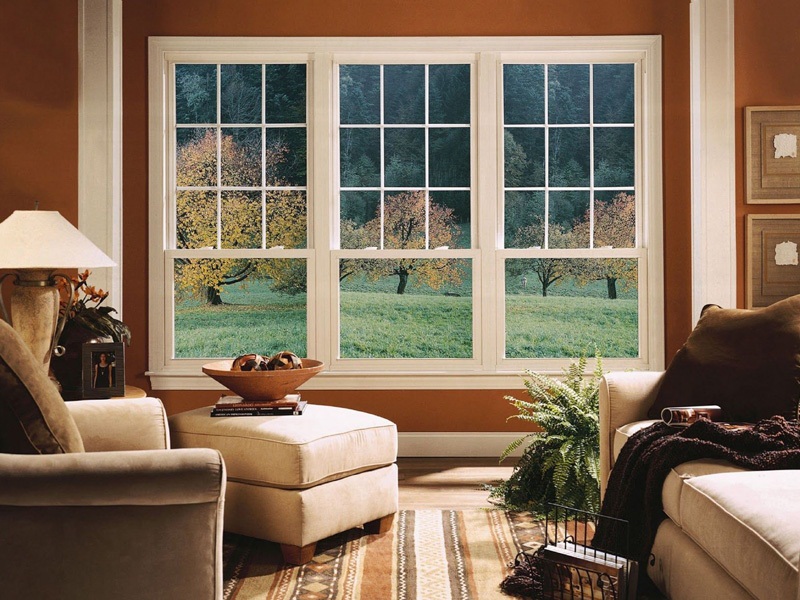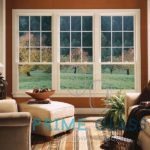You may have encountered the terms muntin and mullion when looking at replacement windows and the different window types. You’ve probably seen them before but might not know the terms. Although sometimes used interchangeably, the two possess unique characteristics that can significantly impact the aesthetics and functionality of windows.
This blog will look at what each of them is, their fundamental differences, and how to decide between them. So, let’s dive in to help you make an informed decision.
What Are Window Muntins
Window muntins are subtle yet impactful window elements, also known as window grills. They are horizontal or vertical dividers that break a single window into smaller panes or grids. They serve functional and aesthetic purposes, adding character and visual interest to a space. Traditionally, muntins were essential structural elements, supporting the glass panes and contributing to the overall stability of the window.
Traditional muntins are thicker and often more pronounced in appearance, creating a classic, timeless look reminiscent of historical architecture. They can be intricately detailed, showcasing craftsmanship and attention to design. On the other hand, modern muntin bars tend to be slimmer and more streamlined, reflecting contemporary architectural trends prioritizing clean lines and a minimalist aesthetic. These sleek versions maintain the visual appeal of divided windowpanes while adapting to modern design preferences.
What Are Window Mullions
Window mullions, on the other hand, are a sturdier option. They are vertical or horizontal elements that divide a window into distinct sections. Unlike muntins, which divide individual panes within a window, mullions separate entire window sections. Think of them as the architectural backbone that provides structural support and defines the overall window structure.
Visually, traditional mullions are often robust and prominently featured, giving windows a classic and substantial appearance. They can be ornately designed, contributing to the overall aesthetic of historical and traditional architectural styles. Conversely, modern mullions tend to be more understated and sleek, aligning with contemporary design preferences that favour clean lines and a minimalist approach. These modern versions maintain the window’s structural integrity while offering a more subtle visual impact.
The primary purpose of mullions on windows is to support the structure, especially in the case of larger windows or those with multiple panels. They also play a crucial role in defining the architectural style of a building, making them an essential element in both form and function.
The Key Differences Between Mullions and Muntins
While mullions and muntins may sound similar and share the common goal of dividing windows, they have distinct characteristics that set them apart.
| Mullions | Muntins | |
| Orientation and Function | Vertical or horizontal elements divide a window into separate sections. They support the window frame, especially in larger or multi-panel windows. | Dividers that separate individual glass panes within a window. Historically, they played a structural role, supporting the glass, but in modern times, their function is primarily aesthetic. |
| Location within the Window | Divide the entire window into sections, creating a distinct framework. | Divide individual panes of glass within a window, adding detail to each section. |
| Appearance | Traditionally, mullions are more substantial, robust and often ornate. In modern design, they may be more streamlined and minimalist. | Traditionally thicker, especially in historic architecture, and can have intricate detailing. Modern muntins are typically slimmer and simpler, aligning with contemporary design preferences. |
| Functionality | Provide structural support to the window, especially in larger or more complex window designs. | Primarily serve an aesthetic purpose, creating a visual grid on the surface of the window. |
| Role in Architectural Style | Play a crucial role in defining the overall structure and appearance of a window, contributing to the architectural style of a building. | Enhance the visual appeal of windows, with traditional versions adding a sense of historical charm and modern versions contributing to a clean and contemporary look. |
Choosing Between Mullions and Muntins
When deciding between mullions and muntins, it’s essential to consider a range of factors that align with your design goals and practical needs. The architectural style of your space plays a pivotal role in this choice; for those inclined towards a classic or historical aesthetic, mullions and muntins can be incorporated, with thicker and more ornate versions echoing traditional design elements.
Conversely, if your design preferences lean towards a more contemporary and minimalist look, sleek and understated mullions or muntins may better suit your vision.
The visual impact you want to achieve is another crucial consideration. Mullions provide a bold and structured appearance, emphasizing vertical or horizontal elements and creating distinct sections in your windows. Conversely, muntins offer a more delicate and intricate visual grid, ideal for those who appreciate detailed patterns within smaller panes.
Functionality should not be overlooked. Mullions are a solid choice for larger windows, offering structural support and added stability to the window frame. On the other hand, if your focus is primarily on aesthetics, especially for smaller window sections, muntins can provide decorative detailing without compromising structural integrity.
Considering your interior design preferences is equally essential. Mullions can contribute to a more traditional and formal ambiance. At the same time, muntins, particularly in their modern and sleek form, can seamlessly complement contemporary interior designs, offering a clean and uncluttered look.
Ultimately, the decision boils down to personal taste. Whether you’re drawn to the bold presence of mullions or the subtle detailing of muntins, your preferences play a crucial role in the overall satisfaction with your chosen window design. Take the time to visualize how each option harmonizes with your vision for the space. Don’t hesitate to seek guidance from design professionals for a tailored approach to your specific needs.
Conclusion
The choice between mullioned windows and muntins depends on aesthetic preferences, architectural styles, and functional considerations. Whether you opt for the bold presence of mullions, defining the structure with emphasis, or the intricate detailing of muntins, contributing to a visual grid of smaller panes, Prime Glass Windows & Doors has a solution for you.
Prime Glass Windows & Doors is ready to assist you with all your glass doors and windows needs! Our expert technicians and installers are ready to help you resecure your premises by offering reliable glass doors and window replacements.
With over a decade’s worth of experience, we have the knowledge, tools, equipment and products to deal with various window and door-related problems. We take pride in ensuring customers are safe in their homes or while on their business premises.
If you need to repair your residential or commercial windows and doors due to an illegal entry or an accident, the Prime Glass Windows & Doors team will do the job.
Got a door or window repair-related emergency? Contact our 24-hour service at (416) 627-0883 today!





